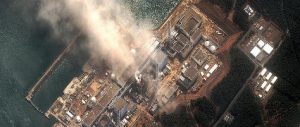Editor’s note: On June 23 this year, the Heinrich Böll Foundation and the China Science Media Centre held a seminar on nuclear solutions and challenges in Beijing. Speaking at the event, He Zuoxiu, a member of the Chinese Academy of Sciences (CAS) and a researcher at the CAS Institute of Theoretical Physics, fiercely criticised China’s “Great Leap Forward” in nuclear development. An edited extract of his presentation is, with He’s permission, made public for the first time here in two parts. In part one, He outlines three lessons he believes China must take from the Fukushima Daiichi nuclear disaster.
Important lesson from Fukushima 1: China must immediately halt its plans for a nuclear “Great Leap Forward”, formulated by a small number of people behind closed doors.
Let’s take a look at China’s planned nuclear “Great Leap Forward”. Today, China has 11 reactors in operation, generating 9 gigawatts of electricity. Twenty-six more are under construction and will generate 28 gigawatts of electricity. The National Energy Administration and Chinese Academy of Engineering are working on targets which will see 70 gigawatts of nuclear generating capacity by 2020, 200 gigawatts by 2030, and 400 to 500 gigawatts by 2050. Nuclear power will gradually become one of China’s main energy sources.
Globally, there are over 400 reactors up and running, generating 400 gigawatts of electricity. Over the next 10 to 40 years, China aims to match, or even exceed that total.
The United States is an example of a nation that rapidly developed nuclear power (although, after the Three Mile Island accident in 1979, it drastically reduced the pace of nuclear development.) Today, the United States has 100 gigawatts of nuclear-generating capacity, and remains the world leader. Within 40 years, China plans to have four to five times the generating capacity of the United States. My question is: has China made the necessary preparations to undertake this “Great Leap Forward”?
These medium- and long-term goals have not been formally signed off by the State Council, but have nonetheless been widely promoted in the media. Part of the blame for the plans can be pinned on a chapter on nuclear power in the Chinese Academy of Engineering’s report “China’s Long and Medium Term (2030-2050) Energy Development Strategy”.
I have read that chapter. In 38 pages, there is only a brief discussion on nuclear safety: nuclear power is referred to as a “safe and reliable energy source” on the basis that “in 2001, the US Nuclear Regulatory Commission carried out quantitative research, confirming that the nuclear power plants reach acceptable safety targets [the probability of disastrous failure is an at acceptably low level] and that safety is adequate at the vast majority of nuclear power plants in operation around the world”. There is no further evaluation or analysis of nuclear safety issues, not even a mention of the 1986 explosion at Chernobyl.
In fact, in a world with 400 nuclear power plants, there have been three major nuclear accidents – a disaster probability of 1%. What are the chances of a major accident in China once it is producing 400 to 500 gigawatts of nuclear-generated electricity? There is an urgent need for scientific analysis. But the Chinese Academy of Engineering’s plan, which provides no detailed discussion of nuclear safety in its 38 pages, has been blithely accepted by China’s energy and environmental sectors. This shows a shameful failure to engage with the pressing issue of nuclear safety.
Important lesson from Fukushima 2: China must end the policy of building at least one large nuclear plant in each province or directly administered municipality.
One driver behind China’s ambitious nuclear policy is the desire to make sure every province or municipality has a high-tech project. Another is local pollution-reduction targets. But, in reality, there are huge differences between the energy demands, climate and geographical conditions of China’s provinces and cities, and these need to be factored in
A nuclear plant requires large amounts of water for cooling (much higher quantities than thermal power plants). That is why, around the world, nuclear power plants are built on inshore islands or coastal spots: to make sure plenty of water is available.
China is a water-scarce nation, and anywhere without ample supply of water is going to be unsuitable for nuclear power plants. True, the Yangtze basin may have adequate supplies of water, and there may be islands or peninsulas on the river suitable for a large nuclear power plant. In the past, I’ve expressed support for nuclear construction in Chongqing, Hubei, Jiangxi and Anhui. But since Fukushima, there has been a fundamental shift in my views. A nuclear incident that polluted the Yangtze River or Yellow River would cause unthinkable devastation for generations to come.
Now, I support a policy of only building nuclear power plants by the sea, and halting construction of all inland plants. Still, if a major nuclear pollution incident were to occur, tens of thousands of tonnes of highly radioactive water might be dumped into the ocean, as happened at Fukushima. That’s why making sure reactors are properly protected against major earthquakes and tsunamis is an absolute necessity – and, of course, this will increase safety costs.
Important lesson from Fukushima 3: All coastal nuclear power plants must include measures to protect against tsunamis.
It’s often said that China has “never been struck by a tsunami”. First, a conclusion like this doesn’t stack up without in-depth research by geographers and marine scientists, and perhaps experts in historical geography. Second, seismic waves spread differently in the ocean and on land. On land, the velocity of seismic waves is strongly dampened as they travel, while in the sea there is only a very small viscosity coefficient, and so tsunamis can travel several thousand kilometres.
The 2011 tsunami didn’t reach China due to the blocking effect of the Japanese mainland and the Korean peninsula. But the Pacific is a wide area of tectonic tension. Another tsunami triggered by a magnitude-nine earthquake could reach China’s eastern and southern seas. A soliton – self-reinforcing – tsunami could travel several thousands of kilometres. Such scenarios may be highly improbable, but they must still be factored into our nuclear policies.
Fukushima teaches us that safety standards for the construction and operation of nuclear power plants have to be even higher than we previously thought – once-in-a-millennium events need to be accounted for (and that includes in existing facilities and those under construction). There can be no “relative” safety. The measures needed to achieve that will of course push up the costs of electricity, but if we are unwilling to bear those, then we must call a halt to the whole idea.
It may be that greatly increased safety costs in China reduce the profits of China Nuclear Power and Guangdong Nuclear Power, or even result in losses. But those higher costs may also increase the lifespan of the nuclear power plants, from the designed lifespan of 30 years to 60 years, meaning there may still be a certain amount of money to be made.
He Zuoxiu is a member of the Chinese Academy of Sciences and researcher at the CAS Institute of Theoretical Physics.
Homepage image by IAEA shows the Fukushima nuclear plant.





